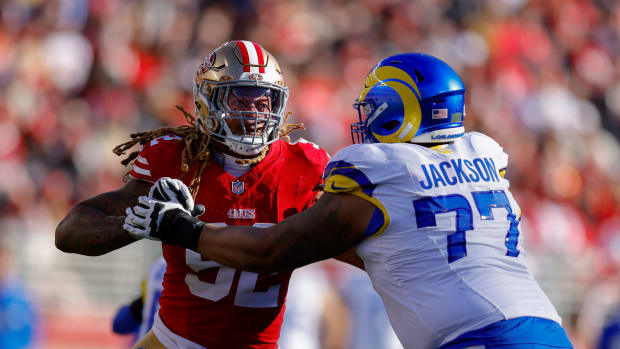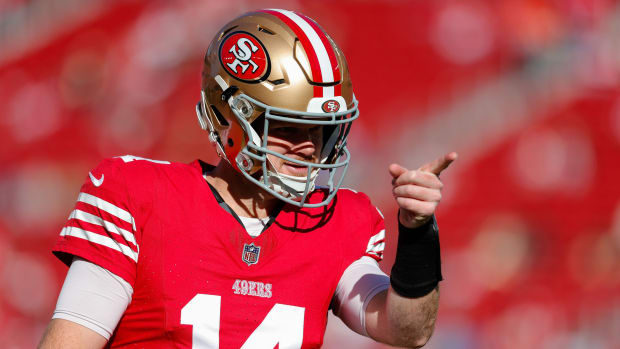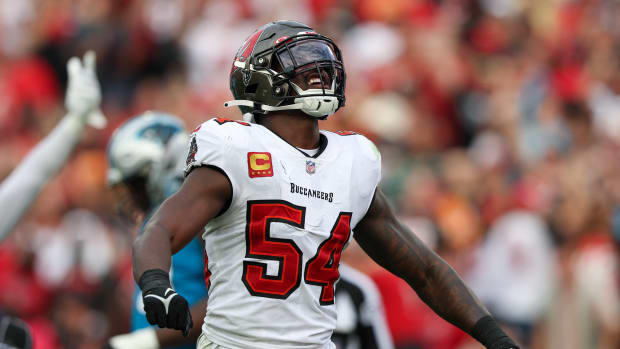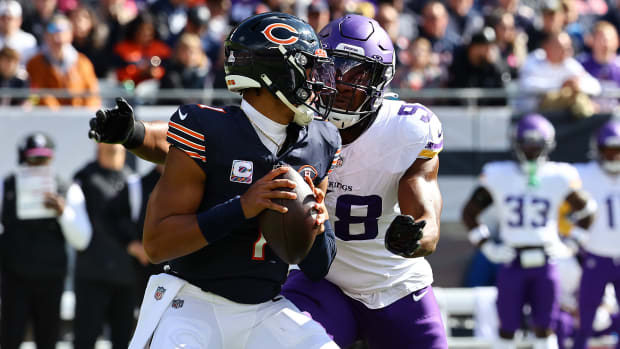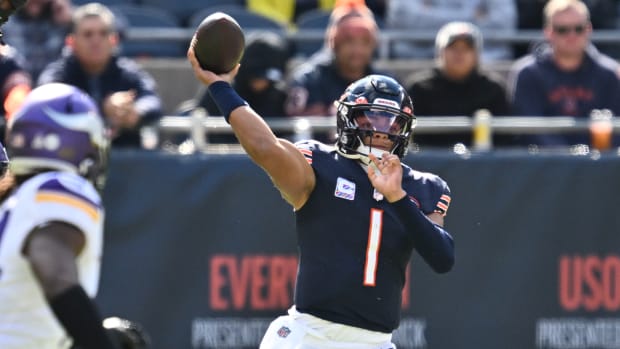How the Bucs Scouted Tom Brady; Why the Stefon Diggs and DeAndre Hopkins Trades Came Together
A transaction this big is always delicate, and so there were moments of disbelief along the way this week—a week that seemed more like a month—for Buccaneers coach Bruce Arians and GM Jason Licht.
By Wednesday afternoon, of course, they knew. I knew. You knew.
But nerves lingered among the handful of guys who were in the office over a tense few days. They were trying to sign Tom Brady, after all, and landing an icon of that level brought the promise that everything from the team’s ability to convert on third down and in the red zone, to the national perception of the franchise was about to change. And then Brady, in the midst of a 90-minute call with Licht and Arians, coolly broke the unrest.
Hey babe, we’re gonna have a lot of fun. This is gonna be a lot of fun.
There was maybe an hour left in that conversation, and still plenty to discuss after Licht handed the phone over to Arians. But as for moments they’ll remember a few years down the line, that was one for the guys in charge in Tampa. It was done.
Brady was about to become a Buccaneer, something that would’ve been hard to fathom when the quarterback left the Gillette Stadium FieldTurf for the last time two months ago, and an idea even Licht and Arians themselves saw as more of a far-fetched hypothetical than real plan for replacing Jameis Winston until last month.
And so it was that when Arians hung up with Brady Wednesday night, he turned and said to Licht, “I think we have a quarterback.”
The Bucs didn’t just get a quarterback; they got the greatest one to ever play. What he’s got left, and he’ll be 43 on opening day, remains to be seen—as does what becomes of the great Patriot dynasty he leaves behind. All the elements of what’s ahead will be fascinating, and we’ll have plenty of time to discuss them.
Here, we’re gonna tell you the story of how the Bucs got here, how months and months of work built toward a tense few days, and how it was capped with an unlikely ending: a franchise that ranks 32nd in all-time win percentage landing a historical No. 1.
***
As the rest of the world shut down, the NFL, for better or worse, kept chugging along. So we did too, and the result, in this week’s MMQB, will be…
• A look at Brady’s final days as a Patriot
• Deep insight into both sides of the Stefon Diggs trade
• A real look at why DeAndre Hopkins is no longer a Texan
• How you should process an aggressive week from the Colts
But we’re starting with the week that everything changed, from a football perspective, on Florida’s gulf coast.
***
After the Bucs went through final cuts as they assembled Arians’s first 53-man roster over Labor Day Weekend in 2019, one thing jumped right off the page at the personnel staff in its plans for the future: There was just one quarterback under contract for 2020, and none under contract for 2021. That one was Ryan Griffen, a career backup set to turn 30 in November.
So while the hope was still there for the Bucs that Winston would break through under Arians, and that Tampa would be re-upping with him before March, Licht, director of player personnel John Spytek and director of pro scouting Rob McCartney had to prepare for that not to happen. Which set into motion those three, and the team’s pro scouts, monitoring quarterbacks on expiring deals, and guys who could be available via trade in 2020.
That part of the process is fairly standard for a personnel department trying to anticipate a future need, even if the stakes are raised when such a need is at quarterback. And that just positioned the Bucs to consider life without Winston.
How did the scouts see Brady? They went back a couple years to trace regression in Brady’s arm strength, and didn’t see a discernible difference in that department in 2019, as compared to ’17 or ’18. He was still poised and patient and had great feel in the pocket. In fact, if one thing stuck out, and Licht did two tours as a New England personnel man, it was that what Brady was running, because of attrition around him, didn’t look like the Patriots’ offense.
That made it a little bit of a tougher evaluation. Still, it stood out that New England was producing despite all that—and showed that Brady remained capable of elevating his teammates to the point where an undermanned unit ranked 15th in total offense and seventh in scoring. And while Licht doubted Brady would make it to the market (Arians was more optimistic on that all along), there was resolve in the front office that the Patriots’ QB could still play.
The season ended with Winston throwing for more passing yards than anyone else in the NFL—and throwing 30 picks. The stage was set.
Offseason, Week 1
Arians’s message to his players in their December 30 breakup meeting was direct: We’re a playoff team if this turnover ratio flips next year. Indeed, Tampa ranked 28th in that category in 2019, with a minus-13. And while Arians wasn’t pointing fingers in that auditorium, it wasn’t hard to find the facts. The Bucs had 41 turnovers. Winston was directly involved in 35 of them, with the 30 picks and five lost fumbles.
The players left the room and the coaches finished up work that week, and that Saturday night, Brady and the Patriots hosted the Titans in the wild-card round. It caught more than one staffer’s attention how the broadcast ended, with Jim Nantz and Tony Romo raising the issue of Brady’s future, how he’d structured his contract and how they’d expected he’d be playing in 2020 but not necessarily with New England. The seed was planted.
The coaches took two weeks off, then reconvened a couple weeks before the Super Bowl. Arians had an assignment for offensive coordinator Byron Leftwich, QBs coach Clyde Christensen and offensive consultant Tom Moore: Spend the rest of January breaking down the 2019 tape of a group of seven or eight available quarterbacks, with Philip Rivers, Ryan Tannehill, Teddy Bridgewater and Andy Dalton among them. Then go back and look at some of 2018 too, and come back with a list of which ones are better options than Winston.
Arians got to work himself, looking at about half the film the other three did, but doing it with more purpose, because he knew exactly what he was looking for. And Licht directed his scouts to do what he planned to and keep their opinions to themselves, so the coaches’ reports would be untainted.
The coaches and scouts then gathered for planning meetings just after the Super Bowl. The consensus top three among Arians’s staff and among Licht’s staff were the same. And the coaches felt like two quarterbacks in the group would be worth moving on from Winston for. Brady was one of the two.
Assessing the fit
Arians’s report back was similar to Licht’s. As he looked at Brady’s tape, the veteran coach—who’d historically worked with big-armed Clydesdales like Ben Roethlisberger, Carson Palmer and Andrew Luck—saw a quarterback who could make every throw his offense required.
He also saw where Brady was being held back. The feeling was that with more speed and explosiveness around him—which the Bucs could give him with Mike Evans, Chris Godwin, O.J. Howard and Cam Brate—Brady wouldn’t be forced to hold the ball like he had his last year in New England, where he had slower skill position talent on hand.
Arians has a saying with his quarterbacks that’s well-worn in football circles: You never go broke putting money in the bank. It took a while for it to register with Winston. Conversely, that mindset basically explains Brady’s point guard–like approach to the position. And where some saw Arians’s bombs-away style as a weird fit for Brady, the coaches saw where they could have Brady putting that money in the bank, hitting faster receivers on the move, running through zones rather than sitting stationary in them.
That, of course, isn’t to say one way is better than the other. Brady’s success in the Patriots offense over the last 20 years, with scores of heady receivers hooking up underneath based on coverage, speaks for itself. This, though, could be something new and exciting for Brady, that would work within Arians’s offense, and accentuate the quarterback’s strengths as a distributor.
And as all this indicates, the wheels were turning on how the whole thing would look.
The legal tampering period
The Bucs didn’t waste time reaching out to Brady’s camp, with the focus, by Monday, on landing the new free agent. Brady was still a day away from announcing his departure from New England, and thus there was still plenty of speculation that the Patriots and their resident legend would reconcile at the 11th hour. But the signals Tampa got from Brady’s people indicated otherwise.
“You made a very good decision to call,” agent Don Yee told the Bucs. And that conversation led the Bucs to believe that money wasn’t really a huge of concern of Brady’s—mostly because it didn’t come up in that initial talk. In fact, all Yee said was that there were boxes that needed to be checked, and Tampa appeared to be checking them.
Yee did, of course, eventually lay out terms to the Bucs, and he would to the Chargers too. Brady wanted a two-year commitment, backed by guarantees. He had a rough ask for $30 million per year, but that was flexible. The big thing was he wanted to allow for his new team to add to its roster where it saw fit.
The deal that wound up being hammered out reflects all that. Brady has a $10 million roster bonus and $15 million base in each year, all of it fully guaranteed. And in both years (we’ll detail this later in the column), he got $2.25 million in performance incentives, and $2.25 million in playoff-related incentives. That means he’s assured of $25 million in each year, with the chance to get to $29.5 million.
Knowing where he’ll be the next two years was important for Brady (hence, the no-trade clause). But the Bucs also never got the feeling that doing the deal this way put a hard end date on Brady’s career—he seemed pretty open, in fact, to the idea of continuing to play for more than two years (hence the no-tag clause in the contract).
The start of the league year
Now, we can get back to the phone call. Because of the coronavirus outbreak, very few staffers were in the office on Wednesday, as the league year began—Licht, Arians, Spytek and cap czar Mike Greenberg were among them. And even if the whole thing was 99% of the way over the goal line, the conversation was one that nobody involved will soon forget.
Arians and Licht were taken aback a bit by the level of research Brady had done, having thoroughly studied the Bucs’ offense and personnel, while explaining, then showing, that he’d kept an eye on Arians’s offense through the years. Licht loved the thought that went into what Brady was saying. Arians got juiced listening to the quarterback’s enthusiasm—to the point where it almost seemed like Brady was selling himself to the Bucs.
Of course, he didn’t need to, and groundwork for how the whole thing would work was being laid. For one, the terminology in Tampa won’t change much based on a premise, which Brady agreed with, that it’ll be much easier for a high-level learner like Brady to pick up something new than it would be for more than 20 other players to adjust to him. But that doesn’t mean Arians won’t change some things.
With Palmer, who was 33 when he started working with Arians in Arizona, there was a fairly simple process of melding what the quarterback knew with what the coach would do. Palmer might have said, “We used to do it like this.” And Arians might have responded, “Actually we stopped doing that because it caused this problem.” In other cases, Palmer would give Arians a concept he loved. Arians might have said, “Yup, we have something just like that.” Or they’d adjust to Palmer. (That came into play, in particular, in third-down and red-zone concepts.)
The idea of it was to collaborate with the quarterback, while keeping the offense simple for everyone else in it. Palmer wound up loving that part of it, and Brady indicated to the Bucs, after going through it, that the idea of that was one of things he was most excited about.
Oh, and as for how excited Brady is? If things improve in our country in time for there to be OTAs this year, the Bucs expect him to be there—after he missed those his last two years in New England.
Done deal
Arians faced Brady twice as a Browns assistant, six times with the Steelers and once with Colts. And even though it’s been seven years since they shared a field, memories he’s got burned in his head from field level over those years—of No. 12 dropping dimes, fist pumping and getting after teammates—give him a pretty good tell on the competitor he’s getting, just the kind he wants. And the kind that, by the way, won seven of those nine games.
Licht, through two tours in New England, had just a casual relationship with Brady over the years. But what he saw in Foxboro over the six seasons they both worked there isn’t hard to recall (Spytek saw it, too, in his time as a Michigan teammate of Brady’s). The bar, in Tampa, is about to be set a little bit higher—and the excitement that other players expressed to the staff over the last few days indicates everyone’s ready for it.
Is age a concern? It’d be hard for it not to be. But the Bucs are banking on a quarterback that they view as of a different breed, who’s already broken old norms by winning championships at 37, 39 and 41 years old. And the hope here is that he’ll leave a legacy in Tampa, in setting a new standard, that’ll last for far longer than he plays.
And yes, all of this is just the ideal that Tampa’s chasing in adding Brady.
Either way, as Brady himself said, seeing how it all turns out should be a lot of fun.
***
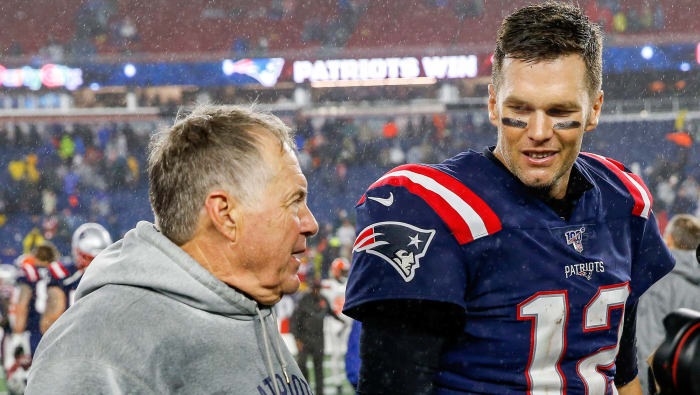
Belichick called Brady a “special person” as well as “the greatest quarterback of all-time.”
Greg M. Cooper-USA TODAY Sports
BRADY'S NEW CONTRACT AND HIS OLD COACH
Here is the breakdown of the two-year, $50 million contract that Brady signed …
2020: $10 million roster bonus, $15 million base, $4.5 million in incentives.
2021: $10 million roster bonus, $15 million base, $4.5 million in incentives.
Performance incentives (in each year): $562.5K each for a top 5 finish in passer rating, yards, TDs, completion percentage and yards/attempt, capped at $2.25 million.
Team incentives (in each year): $500K for playoffs, $750K for a playoff win, $1.25 million for making the NFC title game, $1.75 million for making the Super Bowl, $2.25 million for winning the Super Bowl.
A minimum of 224 attempts is required for performance incentives, and 75% playing time for team incentives.
There are two interesting things here. First, the gross total of the deal, $50 million, is actually less than that of the Patriots’ extension offer last summer (that was $53 million over two). The difference? Brady’s money is guaranteed this time, and that’s really what he wanted from New England eight months ago—an assurance for the years he was signing for. Second, those incentives are very similar to the ones he had in 2018 with the Patriots, when the team built them into his deal in lieu of giving him a raise.
And that doesn’t feel like an accident. It feels more like a driving home of the point he’s tried to make before, that it was more about a team’s commitment to him than it was about the raw dollar amount in the contract, something that permeated Brady’s final days as a Patriot.
It was right after the first of the month, right after the combine on March 2 or 3, when Belichick and Brady had that ballyhooed phone conversation. Whether you want to believe it was business as usual, or where things really went wrong, what we know now is that it was the final substantive discussion between team and player about Brady continuing forward with the team.
And I’ll say what I was saying at the time: I do believe there were terms under which Brady would’ve returned, and terms under which Belichick would’ve had him back. But my sense is that Brady learned that day that the terms for each didn’t match up, and maybe he knew that much, in the back of his mind, all the way back in August.
Either way, after they hung up, Brady wasn’t going to beg for his job back and Belichick wasn’t going to drive to his doorstep to recruit him. Which ultimately spelled the end for the most successful coach/quarterback partnership in NFL history, and maybe the most prosperous coach/player pairing in sports history.
So things are icy now.
But on that, I’ll leave you with this: Those two guys will be OK. Their careers will play out, and when it’s over they’ll reconcile. Why? Because there’s no one more disciplined at separating his personal and professional relationships than Belichick. And in a team-issued statement, you could see Belichick subtly moving Brady from one category to the other last week.
“I am extremely grateful for what he did for our team and for me personally,” Belichick wrote. “Sometimes in life, it takes some time to pass before truly appreciating something or someone but that has not been the case with Tom. He is a special person and the greatest quarterback of all-time."
There, Belichick was saying what he never would have said about Brady while Brady was on his team. But with Brady gone, Belichick was freed from his self-imposed policy to say what he’s probably felt for a long time. And it reminded me of a story Drew Bledsoe told me a few years back.
Bledsoe couldn’t stand Belichick, for obvious reasons, after all that went down in 2001, and didn’t go back to Foxboro for years after his retirement as a result. Then, in 2011, he was elected to the team Hall of Fame. As part of his trip for his induction, Bledsoe went out to a practice, and was nervous about seeing Belichick, not knowing what he’d say. And then, as he made his way to the field, he saw him.
Over came Belichick with a smile on his face. He asked about Bledsoe’s kids. He asked about his wife. He asked about his burgeoning wine company. He was warm and engaging, and a totally different guy than Bledsoe remembered playing for, and the two have been friendly since.
So somehow, despite all the animus the last couple years, I think Brady and Belichick will eventually look back on all this, laugh and probably tip a couple remembering how they used to dominate the hyper-competitive world of pro football.
***
HOW THE DIGGS DEAL HAPPENED SO FAST
I know we covered it earlier in the week, but the trade of Stefon Diggs from Minnesota to Buffalo continues to fascinate me. So here’s some more on the deal that sent Diggs to the Bills, packaged with a seventh-round pick, for first-, fifth- and sixth-rounders in this year’s draft, and a fourth-round pick in 2021.
• Diggs’s tweet on Monday, believe it or not, actually did spark talks. The receiver posted at 2:46 p.m. ET, in the wake of the Kirk Cousins extension: “It’s time for a new beginning.” The cryptic message led to a handful of teams calling Minnesota, which had all but put Diggs off-limits ahead of the trade deadline.
• The Bills had done their homework on Diggs, because they’d been aggressive with the Vikings before the trade deadline in October, calling several times about his availability. One thing that helped: Buffalo college scouting director Terrance Gray was working for the Vikings when Diggs was drafted, so he helped provide insight into what makes Diggs tick.
• The Bills reached out to the Vikings around 4 p.m. ET, about an hour and 15 minutes after Diggs’s tweet. In the fall, Minnesota had given off the vibe that it would’ve taken two 1s, or maybe a 1 and a 2 to pry Diggs away. After a few calls, it was clear the Vikings—mostly because this wasn’t an in-season situation—had softened just a little on their stance.
• After a few calls back and forth, the Vikings mentioned Percy Harvin as a model for the trade. In 2013, Minnesota got first-, third- and seventh-round picks from Seattle for Harvin. That was a little rich for the Bills’ blood, but they could get in the ballpark. In the 9 p.m. hour, the Vikings asked teams involved for their best offers.
• By then, the herd had been thinned. The Patriots were one suitor, but events of the day caused their interest to cool. Franchising Joe Thuney put cap space at a premium for New England. And as Brady’s departure started to look more likely, trading for a veteran receiver made less sense.
• At 9:45 p.m., the Bills called the Vikings back with the framework for what wound up being the deal. The logic for Buffalo? Emmanuel Sanders might’ve been the best free-agent option out there for the Bills at a need position, and Sanders was six-and-a-half years older. And if you packaged the picks involved—the Bills resolved not to deal a 3—then it only would’ve gotten Buffalo from 22 overall to about 18 or so, which might not be high enough to get a Jerry Jeudy or CeeDee Lamb in April.
• Diggs would be more ready than a rookie for Buffalo, and addressed specific needs beyond just the need at the position. The Bills’ inability to beat press coverage hurt the team down the stretch, particularly against New England and Baltimore. Diggs’s specialty? Beating corners 1-on-1 off the line. And he brings a big-play element that should help unlock Josh Allen’s most tantalizing trait—his howitzer of a right arm.
• The Vikings, conversely, have plenty of time to shore up what’s now a hole on the roster. The receiver class in this year’s draft is deep. With the 22nd and 25th picks, the Vikings can move up or down, and find someone to pair with Adam Thielen without having to do anything panicky.
• Cap-wise, this one works both ways. The Bills have a ton of space. The Vikings don’t. So Minnesota gets room to maneuver, maybe keep safety Anthony Harris (if the right trade doesn’t come along) and start to plan with young stars like Dalvin Cook. Buffalo, meanwhile, has been judicious with its financial flexibility, and this was a rare chance to get a good No. 1 receiver at a cut rate. The 25-year-old is signed for the next four years for just $47.5 million.
In the end, the deal worked for both sides. Which is probably why a deal prompted by a tweet was possible to do in about six hours.
***
WHY THE TEXANS HAD TO TRADE HOPKINS
Let me start here: I get the shock over the Texans’ return for DeAndre Hopkins. The Texans got a 2, took on David Johnson and his contract, and swapped 4s with the Cardinals, and Arizona walked away with a player who’s been first-team All-Pro three years running. And that doesn’t seem like much when you consider that Diggs and Odell Beckham fetched first-round picks, plus additional draft capital, and Brandin Cooks twice was traded for a 1.
But all that ignores the rest of the story, which explains why Houston couldn’t get more for a player of Hopkins’s caliber. So here’s that…
• Hopkins wasn’t looking for an extension; he was looking for a raise on his existing contract, which has three years left on it. And word other teams had gotten was that he wanted around what Julio Jones got, more than $20 million per year. If you’re the team trading him, that makes it exponentially more difficult to move even a star player—Antonio Brown would be Exhibit A there. Last year, the trade market for Brown crashed when it became clear he wanted a similar adjustment to what Hopkins is asking for. Brown wound up getting it. The $39 million he had left over the three remaining years of his contract was bumped to about $50 million, and that happened without any years being added to the deal. Which is why the Raiders were able to get him for a third- and fifth-round pick. Very few other teams were willing to do what they did.
• There was friction with Hopkins inside the organization, and really it had everything to do with Monday-to-Saturday. On Sundays, he was exemplary. The rest of the week, his practice habits (he didn’t practice much at all) became a problem, and because he was such a big star he had the ability to carry teammates in the wrong direction—guys who might not be able to turn it on come game day as easily as he could. And that was, if not easy, manageable. That said, it’s one thing to keep a guy who may not totally align with the program on an existing contract. It’s another to reward him with a new contract with three years left on that deal, and have to handle the message it sends to the locker room. And those intangible elements, by the way, are central to how EVP Jack Easterby is trying to help O’Brien rework the organization.
• The Texans have big contracts coming up. Deshaun Watson will eventually get paid, whether it’s this offseason or next. And if he’s not signed before Patrick Mahomes, then Houston will likely be negotiating with him at astronomical numbers, even compared to where the top of the QB market is now. Laremy Tunsil’s another big-box deal the team is working on, and an adjustment to Hopkins’s deal (Hopkins likely wasn’t showing up without one) would likely be considered in those negotiations, which will almost certainly make Tunsil the NFL’s highest-paid offensive lineman. And then there are others, like linebacker Zach Cunningham and (if healthy) receiver Will Fuller that the team needed flexibility to take care of.
• There’s also the argument over the value of a top receiver vs. other positions, and it’s worth noting that Sean Payton and Bill Belichick both traded away Brandin Cooks, the Steelers dealt Brown and the Giants probably aren’t looking back at the Odell Beckham trade with much regret. Receiver trades get a lot of attention because it’s much easier to judge how good they are versus, say, a left tackle or a pass-rusher. And usually the team shipping the receiver out gets grief—the Giants and Steelers sure did last year. The truth? The truth is it’s much easier to draw a correlation between winning and investment in the lines of scrimmage than between winning and having a great No. 1 receiver.
Now, all of this said, this might wind up being a disaster for Texans. I don’t know one way or the other. I’d just reason that the conventional wisdom being thrown around about the trade is more than a little shaky, given the conditions in place, and how big-time receiver deals have gone in the past.
And I’d say all that thinking that having Hopkins should great for Kyler Murray, and Kliff Kingsbury should be a better fit for Hopkins as a coach. I’m told this deal came out of the blue for the Cardinals; they didn’t even discuss it in Indy, and it’s a good gamble for them. Arizona’s just entering the window it has to spend with a quarterback on an affordable rookie contract, and the idea of Hopkins running through the secondary on scramble plays with Murray holding the trigger is a scary one, for sure.
But if we’re calling this what it is, then the whole picture should be taken into account.
So what’s next for Houston? What’s next is Watson firmly in place as the face of the offense, a role that I’d tell you the Texans are pretty comfortable with.
***
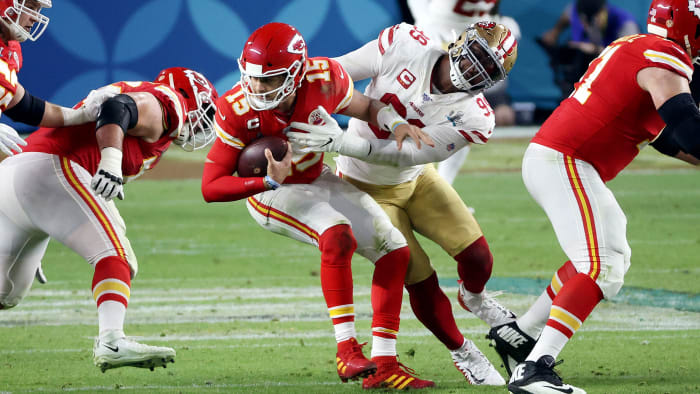
Buckner, who had 1.5 sacks in the Super Bowl, will bolster an Indy pass rush that was just 24th in QB pressures.
Geoff Burke-USA TODAY Sports
COLTS STICK TO THE PLAN
Because they went 7–9, it’s easy to think the Colts headed into this offseason having lost all the momentum they’d gathered before Andrew Luck retired—momentum driven by a fast-improving roster with young All-Pros like Quenton Nelson and Darius Leonard, and the work that GM Chris Ballard and coach Frank Reich had done in establishing a new program.
This week proved they wouldn’t agree with that. Ballard’s had cap space to work with the last few years, but he’s focused on value signings like, for example, corner Pierre Desir (2017), defensive lineman Denico Autry (2018) and tight end Eric Ebron (2018). Some have worked, others haven’t, but the veteran market has been navigated with a focus on maintaining flexibility.
Why? Because blue-chip-players generally aren’t available in free agency. And when one becomes available, you want to be free to pursue him.
That’s where DeForest Buckner came into the picture for Indy. The Colts had a crying need for pressure players for their defensive front, and that’s just what Buckner is. He was probably one of the two best players in the Super Bowl (Nick Bosa was the other) before Patrick Mahomes took over in the fourth quarter. He had 12.5 sacks in 2018, was second-team All-Pro in 2019 and just turned 26 last week.
So the Colts spent some of the cap space they’ve hoarded (and the 13th pick in the draft) on Buckner, because, again, he’s way better than what’s normally out there. And then they addressed the hole that Luck left with some more of that cap space, without compromising their breathing room going forward (they’ll absorb all $25 million of Philip Rivers’s money in 2020; none of the cap charges are being mortgaged).
Ultimately, I think this leaves the Colts in pretty good shape. They have Buckner. And now they have a little time to find the successor for Rivers, a good thing given that they were very unlikely to take a quarterback with the 13th pick in the first place.
***
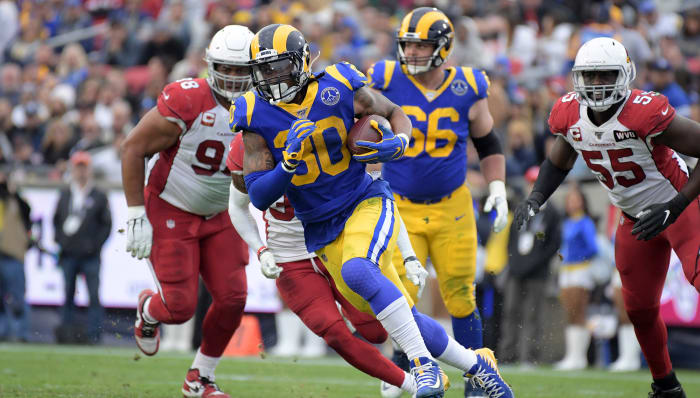
Gurley, who played just 73 games for the Rams, leaves as the franchise’s sixth-leading rusher.
Kirby Lee-USA TODAY Sports
TEN TAKEAWAYS
1) Last week, after Todd Gurley was released, the Rams put out this video to thank him—“Forever a part of our history.” And within a couple hours, a personnel director texted me with a link to it, saying, “This is incredibly sad. The guy’s like 25.” (Indeed, Gurley turns 26 in August.) That running backs have the longevity of gymnasts isn’t a new idea to anyone. But I guess I’d never really thought of it quite that way before. The Rams did what they had to do. It was either eat the $7.55 million roster bonus for 2020, and accept that they paid $34.5 million over two years for a declining player; or commit to this year, and look forward to assuring he’d make at least $45 million over three years, with the chance things get worse. That was really it. (He proved untradeable because of the guarantees in his deal, his injuries and his recent performance.) And so the Rams moved on, taking the hit for a terrible contract, but with the knowledge that it may have just been the price of doing business with a player who was a big figure in the team’s move from St. Louis, the construction of Sean McVay’s program in L.A. and Jared Goff’s development.
2) The Niners’ trade of Buckner was an interesting one—and again shows how San Francisco looks at moves like this with a global picture of their roster in mind. Do they love Buckner as a player? Yes. But they already paid Dee Ford, will be looking at a huge deal for Nick Bosa down the line, and had Buckner and Arik Armstead coming up for deals virtually simultaneously. They couldn’t pay everyone. Buckner’s probably a better player than Armstead, but it was close enough to where they could consider what each might bring home as an asset. And Buckner, a year younger and with a year left on his contract, was worth more in that regard. So they keep Armstead, land the 13th pick in the draft and, with a few bucks saved (the difference between what Armstead and Buckner will make) kept another important piece of their defense in safety Jimmie Ward. All the way around, the idea was making the best of the situation in front of them. This is also why, by the way, after Brady got word of his interest to the Niners earlier this month, the only way I believe it would’ve happened (and I’ve said this in a few different places the last couple weeks) would’ve been if some team came along and blew San Francisco away with an offer for Jimmy Garoppolo.
3) It was a weird week for NFL teams, no doubt, in trying to navigate the early stages given the state of things in our country. I talked to one GM who was running the show from his dining room table and one doing it from his home office. I talked to another who had his top lieutenants and two cap guys in the office, with all the pro scouts and coaches (even the head coach) working from home. A third had his pro scouts, his cap people and his head coach in-house, but everyone else operating remotely. We mentioned above that the Bucs just had Licht, Spytek, Greenberg and Arians in the office. And there was another team that had, for the most part, everyone in. Each team did it a little differently. Some teams in states where more strict coronavirus measures were taken had no choice. Others tried to take social distancing as seriously as they could. And for all those in personnel departments—this being their busy season—this is just the start. As we get closer to the draft, the practice of putting a board together, holding meetings, collecting medical information, and finalizing scouting reports, among other things, will be different than ever before. And someone brought this up, too—what if a GM gets quarantined the week of the draft? These, of course, pale in comparison to issues facing other people in our country. But they will have to be addressed going forward. And the league and union have started working on that—the required release of medical records for free agents is part of it—knowing there are still a lot of hurdles ahead.
4) The Jets have long planned to revamp their offensive line, and GM Joe Douglas, not yet a year into the job, wasted very little time taking action in that area. With a limited budget, the team re-signed guard Alex Lewis, and signed tackle George Fant, guard/center Josh Andrews and center Connor McGovern, all of whom are considered smart, athletic and competitive, and all of whom remain in their 20s. The addition of Greg Van Roten veered a little—the ex-Panther is 30—but he’s also a more mobile lineman who’ll fit into Adam Gase’s wide-zone scheme. And I’d bet more help is coming in the draft, maybe with a long-term left tackle early in the first round. Regardless, the line Sam Darnold lines up behind in 2020 is going to look a lot different than the one that protected him last year, which, again, was pretty much the plan going back to when Douglas took the job last spring.
5) There’s no question which players are most affected by the current set of circumstances that NFL teams are in: It’s the injured guys. Cam Newton is one good example, in that few GMs or coaches would be ready to roll the dice on trading for him to start at the money he’s slated to make ($19.1 million) without having team doctors get a good look at his right shoulder and left foot. Likewise, Jadeveon Clowney’s lengthy medical history (he’s had microfracture surgery) is difficult for teams to get comfortable with if getting him in-house is impossible. So those guys could be stuck in a situation where they either have to sign deals that expose them to some risk, or just wait out the quarantining before finding a new home. And even with guys who are healthy, teams are protecting themselves. In fact, I heard that one club is agreeing to pay just one-third of new players’ signing bonuses based on independent physicals, with the other two-thirds payable when the team doctor can clear him. Weird times, indeed.
6) As for the draft, and we’ll get more into the complications teams are facing there in the weeks ahead, guys who weren’t invited to the combine are in a tough spot. Without physicals on the books, and without an ability to visit teams and meet with team doctors, players are going to need their agents to be creative in getting clubs all the information they need ahead of the draft.
7) Speaking of Newton, it sure seems like music has stopped on the quarterback carousel, and he, Jameis Winston, Joe Flacco and Andy Dalton still don’t have chairs. One of the aforementioned issues for Newton is there for Dalton too: He’s still on a roster, and has a sizable financial number ($17.7 million in cash) for 2020. Another of Newton’s issues, durability, will come up with Flacco. With Winston, given his off-field issues, an inability to visit teams and discuss his growth as a person is a hinderance. So where would there be spots for these guys? New England appears to be off the board now, with three quarterbacks on the roster and little cap space to work with. And the Chargers seem content to move forward with Tyrod Taylor, while taking a hard look at drafting a young quarterback in the top 10. So it seems like the best shot for these guys might be finding a place where the starter is either older (Pittsburgh?) or on shaky ground (Washington?), which worked out nicely for Tannehill last year.
8) Count me among those who think Melvin Gordon made the wrong call holding out last year—something that’s been proven out with what he got (or didn’t get) in free agency. But I’ll interpret the final result of this (a two-year, $16 million deal with the Broncos, after turning down more from the Chargers last summer) a little differently than most. I actually think holding out was the right idea. I just think he did it a year too late. Gurley got paid after his third year, and Zeke Elliott held out to make sure he’d get his after Year 3, too. Atlanta’s Devonta Freeman didn’t hold out after three years, but he did press the issue and wound up getting paid. And Saquon Barkley will be eligible for a deal in 2021 and should do all he can next year to get his big second contract right then and there. Here’s the thing—after three years, it’s easy for a team to look at it and say, “We probably get three or four more good years out of him,” swallow hard and do a contract with a star back. After four years? It’s that much more difficult, which is why you see so few non-first-rounders hit the market coming off their rookie deals actually cash in. This will get more difficult, of course, with stronger rules against holding out in the new CBA. But if there’s one group of players that should take that kind of hard line, it’s running backs.
9) Good for Malcolm Jenkins, getting to go “home” to New Orleans to finish his career. I remember Ohio State coach Jim Tressel telling me when Jenkins came out in 2009 that his first-round corner prospect was the best leader he’d ever had. And those words foreshadowed what was ahead. In five years in New Orleans before leaving for Philly, a young Jenkins was twice named a captain, and matured into a field general too with the position switch to safety. Since being in Philly, he’s been a captain every year the team has had them (Chip Kelly didn’t have formal captains). And that leadership is one reason why Saints coach Sean Payton counts losing Jenkins in free agency in 2014 as his biggest personnel misstep in almost a decade-and-a-half at the helm. In rectifying that one, Payton’s bringing in a guy who should be a strong unifying force (as linebacker Demario Davis has been) for a fast-improving defense.
10) It was amazing to see the number of ex-Patriots going from Foxboro to Detroit and Miami this week. As the Lions dealt away disgruntled CB Darius Slay, Matt Patricia and Bob Quinn imported defensive tackle Danny Shelton, linebacker Jamie Collins and safety Duron Harmon. And the Dolphins signed linebackers Kyle Van Noy and Elandon Roberts and center Ted Karran, in addition to bringing on ex-Eagles linebacker Kamu Grugier-Hill, a 2016 Patriots draft pick who wound up cut but spent camp that year with Brian Flores as his position coach. My first instinct looking at all this? That they are are paying guys Bill Belichick wouldn’t. But then, it’s easy to forget that once upon a time, Belichick did the same thing, in bringing players like Bryan Cox and Roman Phifer (integral parts to his first title team) with him from the Jets.
SIX FROM THE SIDELINE
1) I like the idea of the NBA playoffs being in the summer. Here’s the thing, though: You’d think that would mean working something out with the union, as far as the players still getting their time off. So would that mean, if the Finals were backed up two months, that the start of the 2020-21 season would be moved back that far too?
2) A basketball player just transferred from Harvard to Ohio State, which must mean Ohio State is MUCH harder to get into than when I was applying to college.
3) I have to think that baseball is going to be the sport hit the hardest when things return to normal. So much of that sport’s viewership is based on people’s habits, and I can still remember how hard the 1994 strike was for MLB. I’d imagine this would be the same, and maybe worse because of how much trouble it now has attracting young fans, and the potential competition from the NBA.
4) After looking around on college sports cancellations, am I right to say the last Division I activity for the academic year that hasn’t been called off yet is SEC spring football practice? And that totally makes sense, right?
5) Bombshell is a crazy movie, and worth checking out, especially in an election year.
6) My one coronavirus observation is pretty straightforward. One of the few positive memories I have of 9/11 was how, for at least a couple weeks, everyone put their swords down and as a country we seemed to come together. It didn’t last that long, and since I was a senior in college, maybe I didn’t have the best context for what I was observing, but it sure did seem like there was an effort by everyone to pull in the same direction. And I just haven’t gotten that feeling this time around, which is sad, and sure seems like a step backward for all of us.
BEST OF THE NFL INTERNET
Give Gurley this: He had a sense of humor about it.
…And he was on fire all week.
Again, tailbacks, get yours while you can.
No matter what you think about what’s coming next for Brady and Brees… this was pretty funny.
Joe Haden going to bat for Darius Slay.
Roethlisberger had to be going for the Unabomber look, right?
Good on the league for doing that.
The Rams were just one of the teams that got creative when they were told they couldn’t announce deals (later in the week, that changed).
When you make history on social media, you get a spot in this space.
Chase Daniel remains a financial king. And the Tweet King remains the Tweet King.
WHAT YOU NEED TO KNOW
Two things this week …
1) Since we’re settling into the offseason now, we’re going from All-32 back to Ten Takeaways in the column. It’ll make this whole thing a little breezier of a read for now, but I’ll still make an effort to take care of every fan base that I can. Also, if you’re reading this deep into the column, you’re obviously both a sick person and a big fan. So for both reasons, we’re always open to your suggestions on how we can make the whole thing better—especially during the offseason, when we’ve got a shot to mess around a little bit with the format.
2) It was good to see Sean Payton being so public with his coronavirus diagnosis, in an effort to get more people to take the situation more seriously (which, of course, will accelerate our course back to normalcy). And yeah, I do think it’s a little messed up that we need people like Kevin Durant and Tom Hanks to get it to really have it hit home with certain corners of the population. But at this point, based on where we all are, every little thing can help, so good on all those people for not being afraid to use their positive tests to get everyone going in the right direction.
• Question or comment? Email us at talkback@themmqb.com.

































